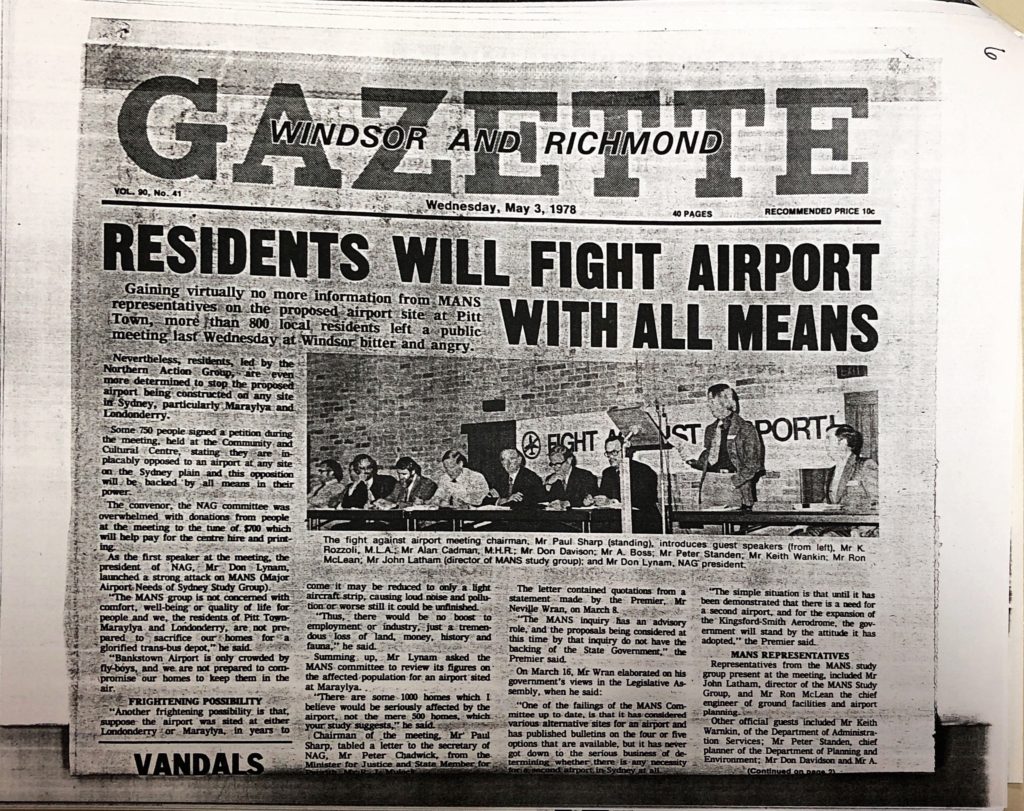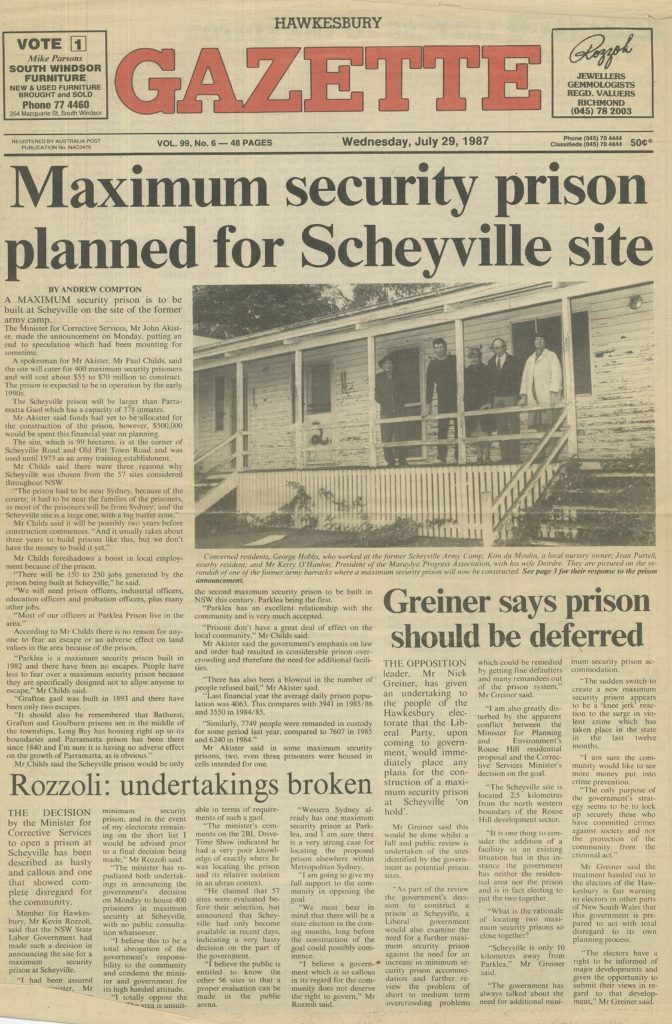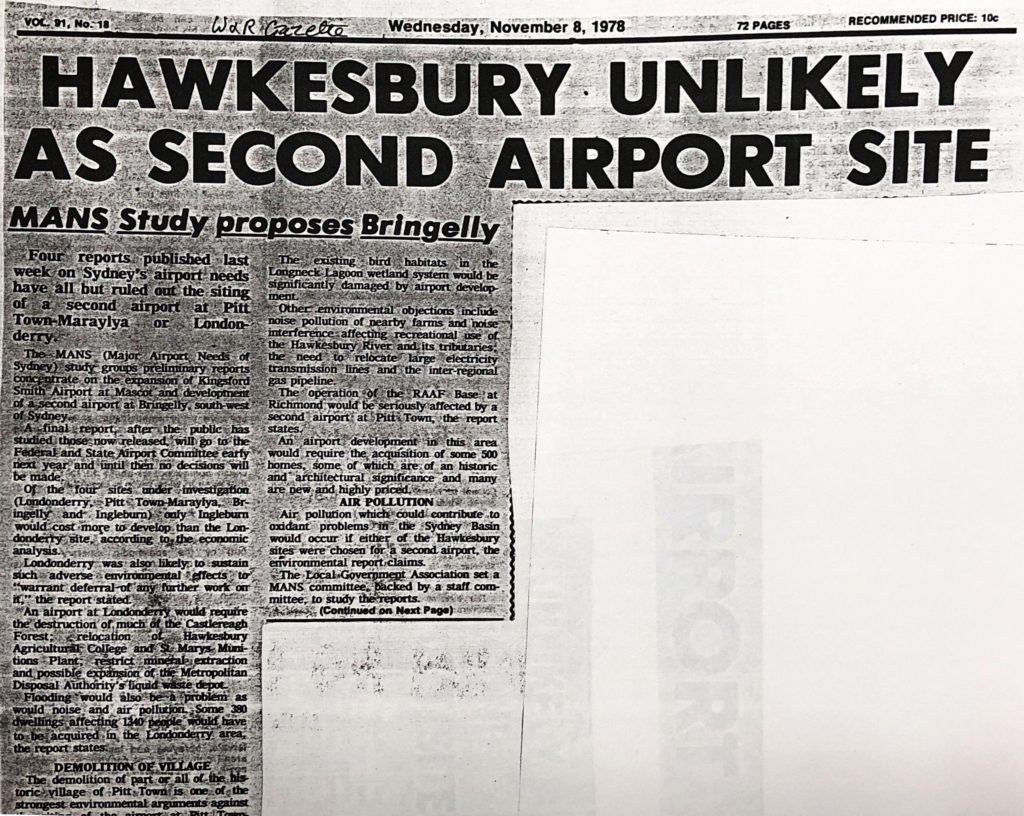This video is the first of two, and explores the history of government attempts to ride rough shod over the community, and what has tended to happen when they try.
It is intended to encourage people engaged in the current struggle to protect the Hawkesbury from two destructive corridor proposals to recognise that these kinds of things have come along before, and the community has generally won.
The second video will be more specifically focused on the reasons why the current proposal is a bad idea.
Transcript:
In this video, the first of a two-parter, a history lesson about why the government’s proposal to drive motorways through the beautiful vistas of the Hawkesbury is deja-vu, all over again.
I’m Nathan Zamprogno, one of your elected Liberal Councillors on Hawkesbury City Council.
Barely two months ago, the State Government announced a consultation period in relation to two proposed road and rail corridors passing through the Hawkesbury district.
The Castlereagh Corridor proposes a crossing of the Hawkesbury-Nepean River at Castlereagh, and then goes through Yarrramundi, Grose Vale, Bowen Mountain, Kurrajong, and rising steeply to join Bells Line of Road at Kurrajong Heights.
The Outer Sydney Orbital or M9 corridor runs north from Camden, passes through the site for the new airport at Badgery’s creek, strikes north-east from Marsden Park and would decimate communities in Vineyard, Oakville and Maraylya.
At some indeterminate point in the future, it is suggested that it will go all the way to Newcastle. Pigs might also fly.
As an elected Liberal, I’m stating my opposition to both corridors.
Even though the State Government is of my party, a dumb idea remains a dumb idea wherever it comes from.
Recently, all four of your local Hawkesbury Liberal Councillors voted unanimously with all the other Councillors to express our concern about these corridors, and to seek a better solution, in a motion passed at Council on May 8th.
I want to explain why, and the best way is a video two-parter.
Both videos are a part of my own submission to Transport for NSW.
You may have cause to agree and disagree with me simultaneously – and that’s because I’m doing my job. I’m aware that I need to represent a range of views. But stick with me.
This video, part 1, is called “We’ve all been here before”
After this, watch part two, called “Surely, we can do better than this?”.
Since everyone loves lists, let’s roll with that.
Point 1: There’s nothing wrong with the idea of corridor reservation.
I promise this is the only overtly political thing I’ll say – so I’ll get it over with.
Look, we criticise governments for failing to engage in long term planning, and we’re especially critical over the issue of transport congestion.
Those of us with an eye to history remember that it was the Wran Labor government who left a ruinous legacy of flogging off road corridors for the M4 and elsewhere in 1977.


Now, taxpayers are left with multi-billion dollar bills for projects like Westconnex, or the north-west rail link – made ridiculously more expensive precisely for the lack of some bold, long term planning decades ago.
But lest you think that I am mounting a defence of wall to wall freeways – think again. Sydney needs a coherent mix of road and public transport networks.
We need to avoid “Los Angeles-isation” of our city. But if this infrastructure barely keeps pace with an eternally growing population, it merely creates the illusion of progress while we actually go backwards in terms of our quality of life, sustainability outcomes, and commute times.
It alarms me that none of our leaders are prepared to ask the question “When will Sydney be full”? It’s a simple enough question, and shouldn’t be heresy.
I’ve used Dick Smith’s compelling documentary “The Population Puzzle” with my students.
It alarms me that Sydney is growing without any leadership on the question of what it’s maximum population should be.
I believe that Australia’s sustainable future lays with both limiting population growth, and providing sharper incentives for decentralisation – sending demand outside of our capital cities. we need to have a period of consolidation in Sydney, so that our infrastructure can finally catch up. People are very angry about this, and it may prove decisive at the next State election.
however, that’s a huge topic which I’ll say more about in another video.
Point 2: We’ve all been here before
Confession: If this begins to sound like a history lesson, it’s because I am a qualified history teacher. But indulge me; because it’s really important to understand some historical context, so we can understand why this kind of thing keeps coming up.
I only need to pick one small part of the Hawkesbury to illustrate in microcosm what happens when governments suffer from these repeated thought bubbles and then ride rough-shod over the community.

Back in 1948, there was a master blueprint for Sydney called the “County of Cumberland” plan. It understood that a healthy city contained a dense core, a ring of urbanised suburbs, and most importantly, green belts that served the city with recreational spaces, productive agricultural land, wildlife preservation and visual amenity.

It was a great idea. And it didn’t last. Sydney wide, the pressure for growth at any cost gradually eroded the green belt idea.
All the land in our neck of the world was farms and rural properties. And the land now next to the proposed M9 corridor, is Scheyville National Park. It was gazetted in 1996. But before it was a National Park, it was one of the largest contiguous parcels of crown land left in the Sydney basin. Which is why, by turns, various governments, Labor and Liberal, state and federal, if I might paraphrase HG Wells, “looked upon us with envious eyes, and slowly, they drew their plans against us”
In 1978, there was a serious proposal to make Scheyville and Pitt Town the site of Sydney’s second airport.

This bubbled away for years. One of my earliest memories, and a kind of political birth for me, was seeing this map of the proposed locations of the runways.
My home at Oakville was underneath one of them. The irony that these airport runways now also lay directly beneath the path of the M9 shouldn’t escape us.

The proposal created uncertainty and dread just like we’re seeing today.

I think it’s significant that, by 1983, the State, Liberal member for Hawkesbury, Kevin Rozzolli, was prepared to speak out strongly on behalf of his constituency. He said:
“Mainland Australians are concerned at the environmental damage that may occur should the Franklin Dam be constructed in Tasmania.
The same people should be concerned about consideration of the siting of an International Airport in the area… variously described as Nelson, Box Hill, Rouse Hill, Maraylya, Oakville and Pitt Town”
“The major factor is not technical feasibility… but whether such construction will so alter the character of the area in which it is located that it will destroy forever a part of Australia’s heritage, a heritage at least as priceless as the Tasmanian wilderness”

I’ll underline that: Our State Liberal member was prepared to liken the natural and historical heritage of Oakville, Maraylya and Pitt Town as analogous to that of the Franklin river in Tasmania. He went on:
“The natural endowments of the area which have created the unique circumstances of its history, scenic beauty and quality of life, demand its preservation as part of Australia’s heritage”.
That heritage is still relevant today.
Dominic? I am calling for you to show the same conviction that your predecessors have.
Let’s move on. In 1987, the same site was announced for a massive, maximum security prison, bigger than Parramatta gaol.

Again, the local Liberal state member for Hawkesbury was in the vanguard in condemning the idea, saying
“I am going to give my full support to the community in opposing this gaol”
In 1991, the Government announced that Scheyville was at the top of a list of preferred sites for a what would have been the largest rubbish dump in the southern hemisphere.
In 1992, the government announced that the same area would be the site for a massive housing development. Hawkesbury Council issued a prospectus that showed bushland at Oakville and Scheyville bulldozed and replaced with a new suburb of 20,000 people, complete with four new primary and high schools, and urban runoff draining straight into Longneck creek.
1992- Scheyville housing development plan_smSo, my point? We’ve all been here before. There’s nothing new under the sun.
But also: People power can win!
Each of these proposals, presented in most cases as necessary and inevitable, were knocked on the head by the community rallying to make the government see sense.
The airport idea was scuttled.

The dump didn’t happen. The prison idea went the same way

And the plans for a massive new suburb? Stopped cold.

And eventually – we got the land around Scheyville gazetted as a new national park. I was 22. It was the year after I first stood for Council. I played a small role in that fight, and I’m kinda proud of it.
You’ll note that I’m not political point scoring here: These rotten ideas were proposed by both Labor and Liberal governments alike.
What matters is people standing up and demanding that their leaders listen to them.
The point of this history lesson is this: People can make a difference, and governments can be made either to see the light or feel the heat.
In the second video, I’ll be listing the reasons why this particular proposal isn’t good enough, and suggesting some alternatives. I hope you’ll join me.